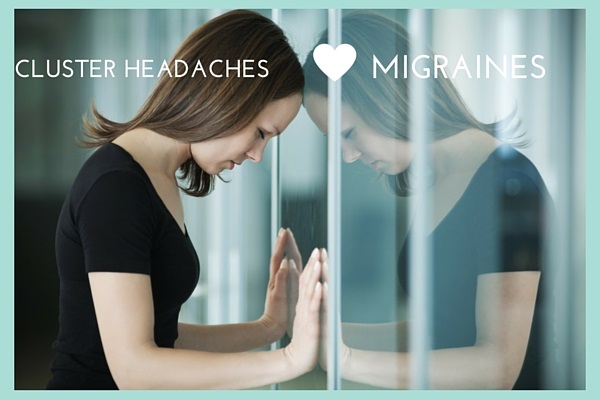Cluster Headaches v. Migraine. This week we are discussing the difference between cluster headaches and migraines. Here is how they differ.
Cluster headaches are rare. However, they are extremely painful and debilitating headaches that occur in groups or clusters. They can often appear during seasonal changes. Some people have described them as “suicide headaches,” due to the excruciating pain and resulting desperation that can occur when you are experiencing a cluster headache.
A migraine on the other hand, is a form of vascular headache. Migraines are caused by a combination of enlargement of blood vessels and the release of chemicals from nerve fibers that coil around the blood vessels. During a migraine attack, the temporal artery enlarges. That is an artery that lies on the outside of the skull just under the skin of the temple. The enlargement of the temporal artery stretches the nerves that coil around the artery and cause the nerves to release chemicals. The chemicals cause inflammation, pain, and further enlargement of the artery. The increasing enlargement of the artery magnifies the pain.
I have experienced both types, and fully understand the description of “suicide headaches” used for cluster headaches. However, migraine pain is also excruciating and debilitating, as you no doubt are well are.

Cluster headache is a type of pain that occurs in brief, severe attacks that affect only one side of the head, and can repeat throughout the day for weeks or months at a time, and then stop for several weeks or months. As with migraines, the pain can be extremely intense or even unbearable.
Cluster headaches can be accompanied by a burning, stabbing, steady pain that often occurs in and around one eye. The pain may intensify and last from 30 minutes to three hours.
Cluster headaches most commonly strike two to three hours after falling asleep, and tend to occur at about the same time every night. If you experience this type of headache, you will be familiar with these symptoms:
- excessive tears
- bloodshot eyes
- runny nose (or stuffy nose on the same side as the head pain)
- flushed face
- agitation
Natural Remedies for Cluster Headache Relief
If you experience cluster headache attacks, some have found relief with the following natural remedies and alternative, holistic therapies:
- Melatonin. In some people with cluster headaches, they have been found to have low levels of melatonin, a hormone that helps regulate sleep-wake cycles. Although scientists have yet to confirm whether taking melatonin supplements can benefit people with cluster headaches, a small study published in 2001 found that melatonin helped alleviate attacks.
- Capsaicin. When taken regularly, capsaicin (the active ingredient in hot peppers) may help prevent the occurrence of cluster headache attacks.
- Stress Relief. Stress is a trigger for cluster headache attacks. Although practices such as yoga and meditation have not been specifically studied for their effects on cluster headaches, they may help stave off attacks by keeping your stress in check.
Causes of Cluster Headaches
As with migraines, the exact cause of cluster headache is unknown. They are possibly related to abnormalities in blood vessels and nerves that affect parts of the head involved in cluster headache attacks. Adult males aged 20 and older, and people with a family history of cluster headaches appear to be at an increased risk for them. Smoking, drinking alcohol, and being under stress can also raise your risk for a cluster headache attack.
When left untreated, cluster headaches can occur repeatedly for years and interfere with your daily functioning. As you know, I am a great believer in the natural and holistic approach when possible. However, there has also been some effective relief by the use of oxygen therapies and physical therapies (such as hot and cold treatments).
As always, treating migraines and cluster headache can be helped by being very aware of what your migraine triggers are. If you don’t know yet what your triggers are, download my FREE eBook, “12 Migraine Triggers and Solutions.”
In addition, if you keep track of your headaches and foods, it can be of great benefit.
For your FREE migraine diary, ==<CLICK HERE<==
Each one of us reacts differently to different things – there is no one-size-fits-all with migraine treatment. However, with that said, if you or a family member have frequent migraines, then I would love to be able to help. I can help you implement some strategies and teach you how to maximize your prevention and help during migraine attacks, and help you to live with less pain and less days of debilitating headaches. Simply contact me to book an appointment for assessment so that we can map out an individualized treatment and prevention plan.
Be the first caller and receive a free paperback copy of my book,
“The Ultimate Migraine Handbook: An Holistic Approach to Pain Relief.”
Be sure to mention this article when you call.


